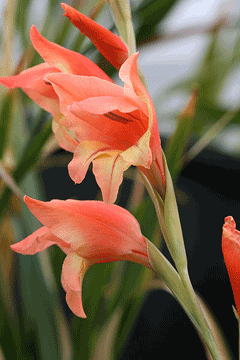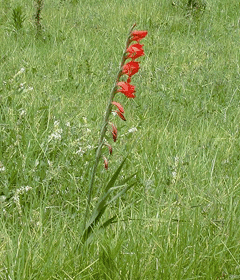 |
|
http://www.flickr.com/people/30555820@N02 |
 |
|
Translate this page:
Summary
Physical Characteristics

 Gladiolus dalenii is a CORM growing to 1.5 m (5ft). It is in flower from July to August. The species is hermaphrodite (has both male and female organs) and is pollinated by Insects.
Gladiolus dalenii is a CORM growing to 1.5 m (5ft). It is in flower from July to August. The species is hermaphrodite (has both male and female organs) and is pollinated by Insects.
Suitable for: light (sandy) and medium (loamy) soils and prefers well-drained soil. Suitable pH: mildly acid, neutral and basic (mildly alkaline) soils. It cannot grow in the shade. It prefers moist soil.
UK Hardiness Map
US Hardiness Map
Synonyms
Plant Habitats
Cultivated Beds;
Edible Uses
Edible Parts: Flowers Nectar
Edible Uses:
Flowers - raw or cooked. The anthers are removed and the flowers are added to salads or used as a boiled vegetable[183]. Children suck the flowers for their copious quantities of nectar[183].
References More on Edible Uses
Medicinal Uses
Plants For A Future can not take any responsibility for any adverse effects from the use of plants. Always seek advice from a professional before using a plant medicinally.
None known
References More on Medicinal Uses
The Bookshop: Edible Plant Books
Our Latest books on Perennial Plants For Food Forests and Permaculture Gardens in paperback or digital formats.

Edible Tropical Plants
Food Forest Plants for Hotter Conditions: 250+ Plants For Tropical Food Forests & Permaculture Gardens.
More

Edible Temperate Plants
Plants for Your Food Forest: 500 Plants for Temperate Food Forests & Permaculture Gardens.
More

More Books
PFAF have eight books available in paperback and digital formats. Browse the shop for more information.
Shop Now
Other Uses
References More on Other Uses
Cultivation details
Prefers a sunny sheltered position in a light sandy neutral to slightly acid soil with a pH between 6.5 and 7[1, 200]. Requires a stony gritty loam. This species is not very cold-hardy, tolerating temperatures down to about 0°c[260]. In Britain it may be possible to plant the corms out in spring, harvest them in the autumn and store them overwinter in a cool frost-free place. This species is one of the parents of the cultivated garden gladiolas[200].
References Carbon Farming Information and Carbon Sequestration Information
Temperature Converter
Type a value in the Celsius field to convert the value to Fahrenheit:
Fahrenheit:
The PFAF Bookshop
Plants For A Future have a number of books available in paperback and digital form. Book titles include Edible Plants, Edible Perennials, Edible Trees,Edible Shrubs, Woodland Gardening, and Temperate Food Forest Plants. Our new book is Food Forest Plants For Hotter Conditions (Tropical and Sub-Tropical).
Shop Now
Plant Propagation
Seed - sow early spring in a greenhouse at 15°c[200]. It usually germinates freely[1]. The seed can also be sown as soon as it is ripe in the autumn in a warm greenhouse[200]. Sow the seed thinly so that the seedlings can be grown on in the pot without disturbance for their first year, giving them an occasional liquid feed to ensure they do not become nutrient deficient. Pot up the small bulbs when they are dormant in the autumn, placing about 2 - 3 bulbs in each pot. Grow them on for another year or two in the greenhouse and then plant them out in late spring. Division. Dig up the corms in October, dry them in well ventilated conditions at about 20°c and then store them in a cool but frost-free place over the winter, planting them out about 10cm deep in April[1, 200]. Cormlets harvested when digging up the corms in the autumn can be stored in a similar manner to the corms[200]. Larger cormlets can be planted out in spring, smaller ones may be best grown on for a year in the greenhouse.
Other Names
If available other names are mentioned here
Native Range
TEMPERATE ASIA: Saudi Arabia, Yemen AFRICA: Eritrea, Ethiopia, Sudan, Chad, Kenya, Tanzania, Uganda, Burundi, Central African Republic, Cameroon, Democratic Republic of the Congo, Congo, Rwanda, Benin, Burkina Faso, Côte D‘Ivoire, Ghana, Guinea, Guinea-Bissau, Mali, Nigeria, Senegal, Togo, Angola, Mozambique, Malawi, Zambia, Zimbabwe, Botswana, Lesotho, Namibia, Eswatini, South Africa (Eastern Cape, Free State, KwaZulu-Natal, Limpopo, Mpumalanga), Madagascar
Weed Potential
Right plant wrong place. We are currently updating this section.
Please note that a plant may be invasive in one area but may not in your area so it's worth checking.
Conservation Status
IUCN Red List of Threatened Plants Status :

Growth: S = slow M = medium F = fast. Soil: L = light (sandy) M = medium H = heavy (clay). pH: A = acid N = neutral B = basic (alkaline). Shade: F = full shade S = semi-shade N = no shade. Moisture: D = dry M = Moist We = wet Wa = water.
Now available:
Food Forest Plants for Mediterranean Conditions
350+ Perennial Plants For Mediterranean and Drier Food Forests and Permaculture Gardens.
[Paperback and eBook]
This is the third in Plants For A Future's series of plant guides for food forests tailored to
specific climate zones. Following volumes on temperate and tropical ecosystems, this book focuses
on species suited to Mediterranean conditions—regions with hot, dry summers and cool, wet winters,
often facing the added challenge of climate change.
Read More
Expert comment
Author
Van Geel.
Botanical References
200
Links / References
For a list of references used on this page please go here
Readers comment
| Add a comment |
|
If you have important information about this plant that may help other users please add a comment or link below. Only comments or links that are felt to be directly relevant to a plant will be included. If you think a comment/link or information contained on this page is inaccurate or misleading we would welcome your feedback at [email protected]. If you have questions about a plant please use the Forum on this website as we do not have the resources to answer questions ourselves.
* Please note: the comments by website users are not necessarily those held by PFAF and may give misleading or inaccurate information.
To leave a comment please Register or login here All comments need to be approved so will not appear immediately.
|
Subject : Gladiolus dalenii
|
|
|
|